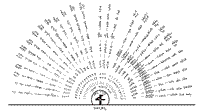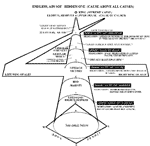




E. ADDITIONAL SMALL FACE VISUALIZATIONS

The primary texts of the Mystical Qabalah have a wealth of allusive imagery
that can be used in an active process of creative imagination, in conjunction
with Small Face-centered meditation practices. The Sefer HaShmoth
(Book of Names) contains numerous Fallen and Perfect two-dimensional
Tree diagrams. The Sefer Yetzirah (Book of Formation)
has several two-dimensional Trees, and the double-pyramid three-dimensional
Tree of Life. It also has the two hundred and thirty one two-letter permutations
of the “Wall,” the
array of the “Sunset,”
and the “Battle.”
 The Tanakh (Torah, Prophets, and Writings)
is especially replete with imagery. The Torah gives us Adam and Chava
(Eve) and the Garden of Eden, Noah and the Great Flood, the stories of the
Patriarchs and Matriarchs, the life saga of Master Mosheh and the liberation
from Egyptian slavery, the extraordinary sequence of events in the desert
of Sinai, the Ark of the Covenant, and more. In Zohar B’reshith
21a-21b, several verses in the Torah
Torah B’reshith 18:1
The Tanakh (Torah, Prophets, and Writings)
is especially replete with imagery. The Torah gives us Adam and Chava
(Eve) and the Garden of Eden, Noah and the Great Flood, the stories of the
Patriarchs and Matriarchs, the life saga of Master Mosheh and the liberation
from Egyptian slavery, the extraordinary sequence of events in the desert
of Sinai, the Ark of the Covenant, and more. In Zohar B’reshith
21a-21b, several verses in the Torah
Torah B’reshith 18:1
Torah B’reshith 24:63
Torah B’reshith 32:32 are cited as meditation
images for Abraham (“sitting at the door of his tent at noon”),
Yitza’aq (“meditating in the field at sunset”), and Ya’aqov
(“limping down the road at sunrise,” after wrestling with Paniel
all night). See diagram. The
books of the Prophets yield images such as King David the Golden
One whirling in ecstatic absorption before the Ark of the Covenant as it
was brought to Jerusalem (II Samuel), Jeremiah bearing a yoke upon
his neck, Ezekiel ascending in the fiery chariot, the Merkabah visions
of Isaiah and Ezekiel, etc. The books of the Writings provide our
imaginations with images from the travails of Job, the story of Yonah in
the belly of the Leviathan, Daniel in the den of lions, and other
spiritual gems.
One might envision the Shekhinah seated in a forest setting, or as
the “Presence of Shadai” stationed between the Kerubim
atop the Ark of the Covenant, or as the Divine Mother in exile wandering
in the Lower Worlds to look after Her children, or as the Bride of the Lord
YHVH on the wedding day of Shabat. You could imagine yourself prostrating
before the “Burning Bush” of the flaming Name YHVH, perhaps offering
your head (i.e. your mind) in your right hand, and your heart (i.e. your
unconditional love) in your left hand. Any of the images from the primary
texts can be used as an adjunct to one’s meditation routine. As mentioned
previously, you can add the name of any of the patriarchs, matriarchs, prophets,
sages, or Messiah to the root mantra “Ani Yod Heh Vav Heh.”
You can visualize one or more of the images before meditation, or in conjunction
with it.